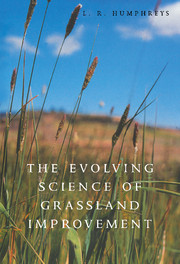Book contents
- Frontmatter
- Contents
- Preface
- Acknowledgements
- Abbreviations
- 1 Grassland improvement and environmental protection
- 2 The plant genetic base for grassland improvement
- 3 The nitrogen economy of grasslands
- 4 Growth and defoliation
- 5 Grassland ecology
- 6 Grazing management
- 7 Innovation, optimization and the realization of change
- Appendix The International Grassland Congresses
- References
- Index
5 - Grassland ecology
Published online by Cambridge University Press: 19 September 2009
- Frontmatter
- Contents
- Preface
- Acknowledgements
- Abbreviations
- 1 Grassland improvement and environmental protection
- 2 The plant genetic base for grassland improvement
- 3 The nitrogen economy of grasslands
- 4 Growth and defoliation
- 5 Grassland ecology
- 6 Grazing management
- 7 Innovation, optimization and the realization of change
- Appendix The International Grassland Congresses
- References
- Index
Summary
Grassland climax and succession
Introduction
Grassland ecology attracts scientists interested in the interplay of the biotic, climatic and edaphic components of the environment as these modify the dynamics of grassland communities. Understanding of the processes involved provides conceptual bases for the management of natural plant communities and may underpin the efforts of those concerned with the use, improvement and conservation of ‘rangeland’ resources. These ecological insights are also directed to manipulating the botanical composition of planted pastures, especially as directed to the maintenance of a herbage legume component or to the control of weeds.
This topic is wide and this chapter is therefore focused on the main areas of controversy: the demise of Clementsian succession, the rise of the stateand-transition model, the replacement of the evangelistic piety of range management by more rational and quantitative assessments of land condition, and the advances in describing the processes of plant adaptation and population change.
The Clementsian monoclimax and its modification
The most influential twentieth century concept in grassland ecology was developed by F.E. Clements and his predecessors (Clements, 1916); they viewed vegetation as a dynamic (and not static) entity in which ‘succession is the universal process of formation development … each climax formation is able to reproduce itself, repeating with essential fidelity the stages of its development’.
- Type
- Chapter
- Information
- The Evolving Science of Grassland Improvement , pp. 129 - 155Publisher: Cambridge University PressPrint publication year: 1997



